A Bioethics Case Study: Exploring Religious Views on Euthanasia
VerifiedAdded on 2023/06/03
|11
|2721
|479
Case Study
AI Summary
This case study delves into the bioethical dilemma of euthanasia through the lens of Christianity and Buddhism, using the case of George to explore differing perspectives. Christian bioethics emphasizes the sanctity of life as a gift from God, opposing interventions like euthanasia that contradict God's sovereignty. Suffering is viewed as potentially cleansing and leading to salvation. Buddhist bioethics, while denying active euthanasia, focuses on preparing for death by detaching from worldly possessions and reflecting on positive achievements. Both religions generally discourage euthanasia, prioritizing the preservation of life and spiritual well-being. The author's opinion aligns with these views, highlighting the potential for recovery and the risk of biased assessments in physician-assisted suicide decisions, referencing examples of individuals who recovered after being considered candidates for euthanasia.
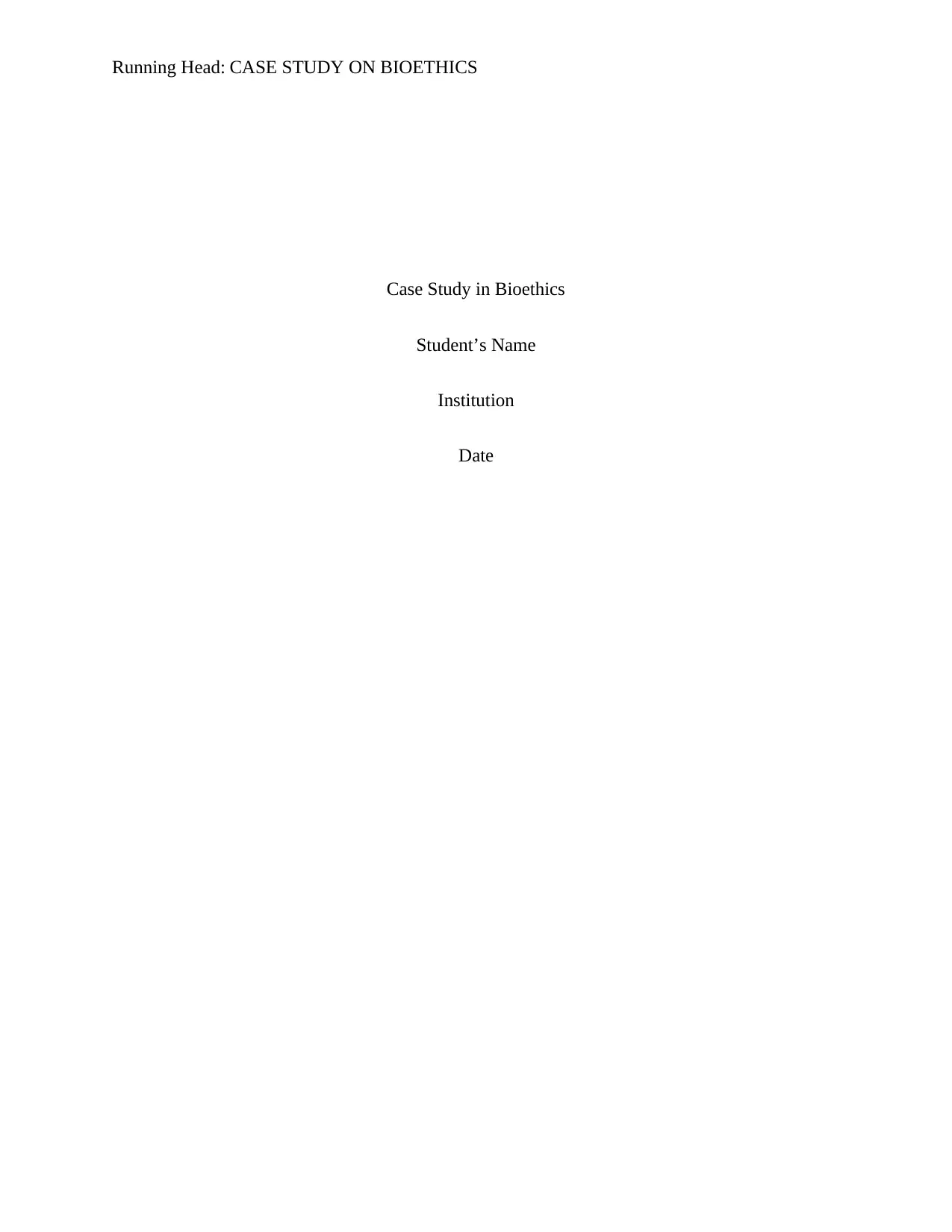
Running Head: CASE STUDY ON BIOETHICS
Case Study in Bioethics
Student’s Name
Institution
Date
Case Study in Bioethics
Student’s Name
Institution
Date
Paraphrase This Document
Need a fresh take? Get an instant paraphrase of this document with our AI Paraphraser
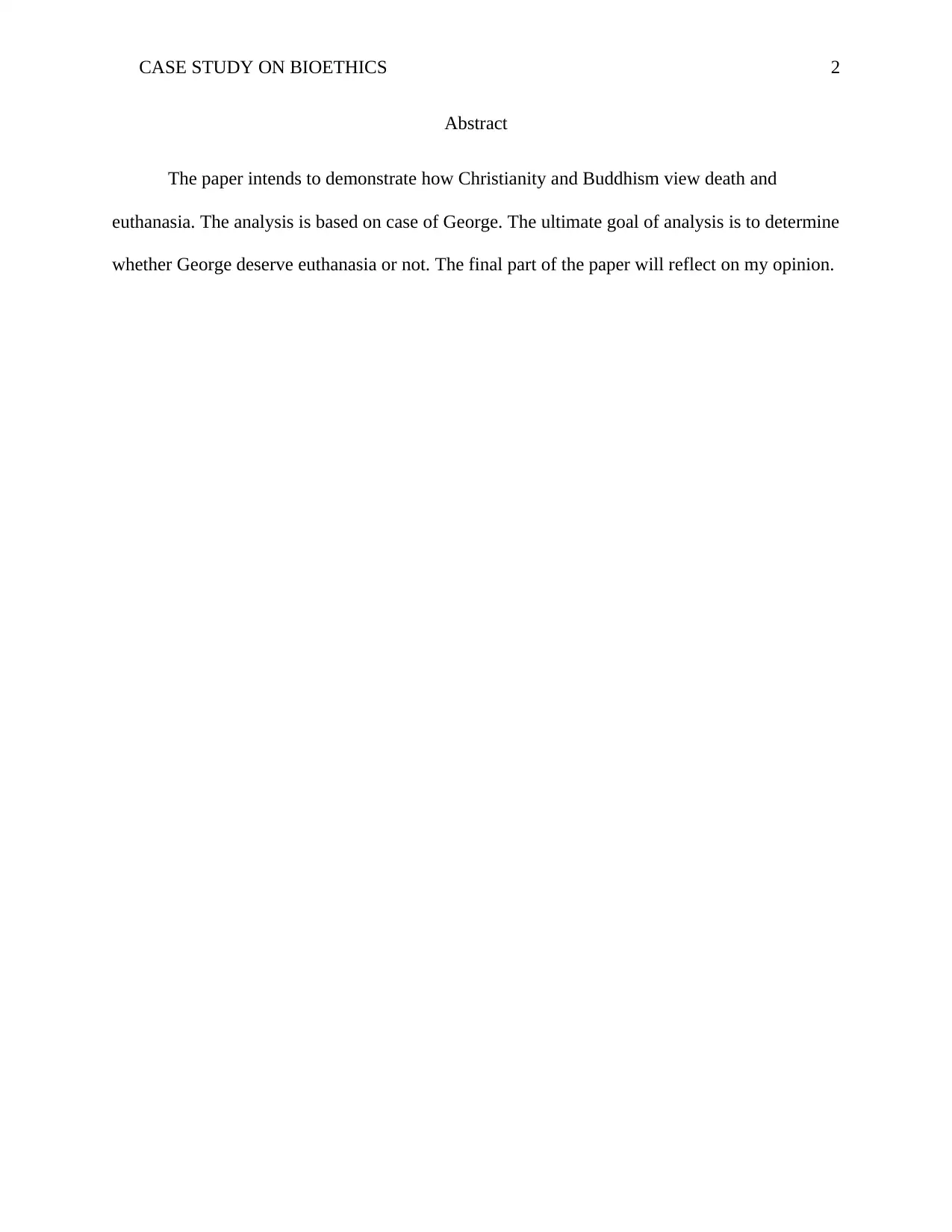
CASE STUDY ON BIOETHICS 2
Abstract
The paper intends to demonstrate how Christianity and Buddhism view death and
euthanasia. The analysis is based on case of George. The ultimate goal of analysis is to determine
whether George deserve euthanasia or not. The final part of the paper will reflect on my opinion.
Abstract
The paper intends to demonstrate how Christianity and Buddhism view death and
euthanasia. The analysis is based on case of George. The ultimate goal of analysis is to determine
whether George deserve euthanasia or not. The final part of the paper will reflect on my opinion.
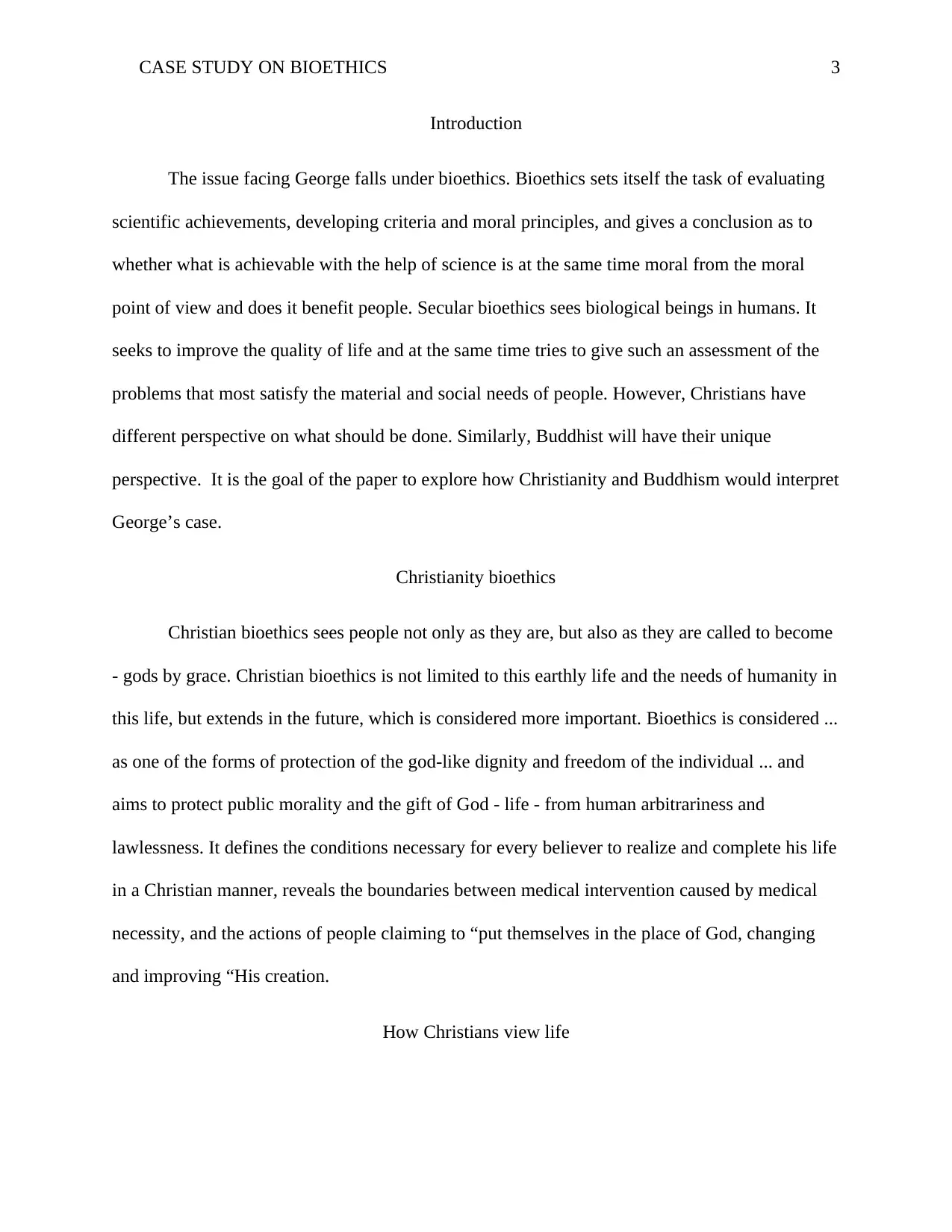
CASE STUDY ON BIOETHICS 3
Introduction
The issue facing George falls under bioethics. Bioethics sets itself the task of evaluating
scientific achievements, developing criteria and moral principles, and gives a conclusion as to
whether what is achievable with the help of science is at the same time moral from the moral
point of view and does it benefit people. Secular bioethics sees biological beings in humans. It
seeks to improve the quality of life and at the same time tries to give such an assessment of the
problems that most satisfy the material and social needs of people. However, Christians have
different perspective on what should be done. Similarly, Buddhist will have their unique
perspective. It is the goal of the paper to explore how Christianity and Buddhism would interpret
George’s case.
Christianity bioethics
Christian bioethics sees people not only as they are, but also as they are called to become
- gods by grace. Christian bioethics is not limited to this earthly life and the needs of humanity in
this life, but extends in the future, which is considered more important. Bioethics is considered ...
as one of the forms of protection of the god-like dignity and freedom of the individual ... and
aims to protect public morality and the gift of God - life - from human arbitrariness and
lawlessness. It defines the conditions necessary for every believer to realize and complete his life
in a Christian manner, reveals the boundaries between medical intervention caused by medical
necessity, and the actions of people claiming to “put themselves in the place of God, changing
and improving “His creation.
How Christians view life
Introduction
The issue facing George falls under bioethics. Bioethics sets itself the task of evaluating
scientific achievements, developing criteria and moral principles, and gives a conclusion as to
whether what is achievable with the help of science is at the same time moral from the moral
point of view and does it benefit people. Secular bioethics sees biological beings in humans. It
seeks to improve the quality of life and at the same time tries to give such an assessment of the
problems that most satisfy the material and social needs of people. However, Christians have
different perspective on what should be done. Similarly, Buddhist will have their unique
perspective. It is the goal of the paper to explore how Christianity and Buddhism would interpret
George’s case.
Christianity bioethics
Christian bioethics sees people not only as they are, but also as they are called to become
- gods by grace. Christian bioethics is not limited to this earthly life and the needs of humanity in
this life, but extends in the future, which is considered more important. Bioethics is considered ...
as one of the forms of protection of the god-like dignity and freedom of the individual ... and
aims to protect public morality and the gift of God - life - from human arbitrariness and
lawlessness. It defines the conditions necessary for every believer to realize and complete his life
in a Christian manner, reveals the boundaries between medical intervention caused by medical
necessity, and the actions of people claiming to “put themselves in the place of God, changing
and improving “His creation.
How Christians view life
⊘ This is a preview!⊘
Do you want full access?
Subscribe today to unlock all pages.

Trusted by 1+ million students worldwide
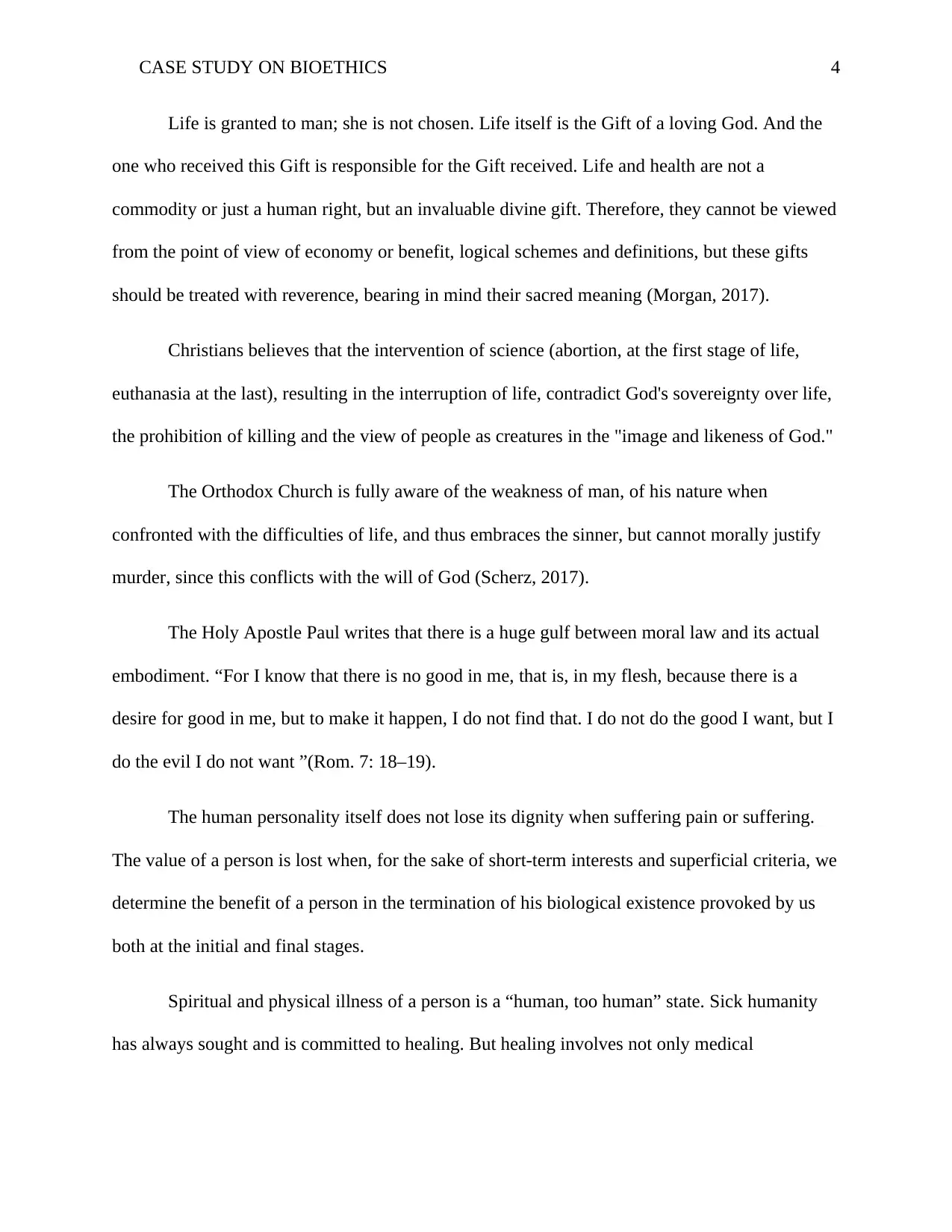
CASE STUDY ON BIOETHICS 4
Life is granted to man; she is not chosen. Life itself is the Gift of a loving God. And the
one who received this Gift is responsible for the Gift received. Life and health are not a
commodity or just a human right, but an invaluable divine gift. Therefore, they cannot be viewed
from the point of view of economy or benefit, logical schemes and definitions, but these gifts
should be treated with reverence, bearing in mind their sacred meaning (Morgan, 2017).
Christians believes that the intervention of science (abortion, at the first stage of life,
euthanasia at the last), resulting in the interruption of life, contradict God's sovereignty over life,
the prohibition of killing and the view of people as creatures in the "image and likeness of God."
The Orthodox Church is fully aware of the weakness of man, of his nature when
confronted with the difficulties of life, and thus embraces the sinner, but cannot morally justify
murder, since this conflicts with the will of God (Scherz, 2017).
The Holy Apostle Paul writes that there is a huge gulf between moral law and its actual
embodiment. “For I know that there is no good in me, that is, in my flesh, because there is a
desire for good in me, but to make it happen, I do not find that. I do not do the good I want, but I
do the evil I do not want ”(Rom. 7: 18–19).
The human personality itself does not lose its dignity when suffering pain or suffering.
The value of a person is lost when, for the sake of short-term interests and superficial criteria, we
determine the benefit of a person in the termination of his biological existence provoked by us
both at the initial and final stages.
Spiritual and physical illness of a person is a “human, too human” state. Sick humanity
has always sought and is committed to healing. But healing involves not only medical
Life is granted to man; she is not chosen. Life itself is the Gift of a loving God. And the
one who received this Gift is responsible for the Gift received. Life and health are not a
commodity or just a human right, but an invaluable divine gift. Therefore, they cannot be viewed
from the point of view of economy or benefit, logical schemes and definitions, but these gifts
should be treated with reverence, bearing in mind their sacred meaning (Morgan, 2017).
Christians believes that the intervention of science (abortion, at the first stage of life,
euthanasia at the last), resulting in the interruption of life, contradict God's sovereignty over life,
the prohibition of killing and the view of people as creatures in the "image and likeness of God."
The Orthodox Church is fully aware of the weakness of man, of his nature when
confronted with the difficulties of life, and thus embraces the sinner, but cannot morally justify
murder, since this conflicts with the will of God (Scherz, 2017).
The Holy Apostle Paul writes that there is a huge gulf between moral law and its actual
embodiment. “For I know that there is no good in me, that is, in my flesh, because there is a
desire for good in me, but to make it happen, I do not find that. I do not do the good I want, but I
do the evil I do not want ”(Rom. 7: 18–19).
The human personality itself does not lose its dignity when suffering pain or suffering.
The value of a person is lost when, for the sake of short-term interests and superficial criteria, we
determine the benefit of a person in the termination of his biological existence provoked by us
both at the initial and final stages.
Spiritual and physical illness of a person is a “human, too human” state. Sick humanity
has always sought and is committed to healing. But healing involves not only medical
Paraphrase This Document
Need a fresh take? Get an instant paraphrase of this document with our AI Paraphraser
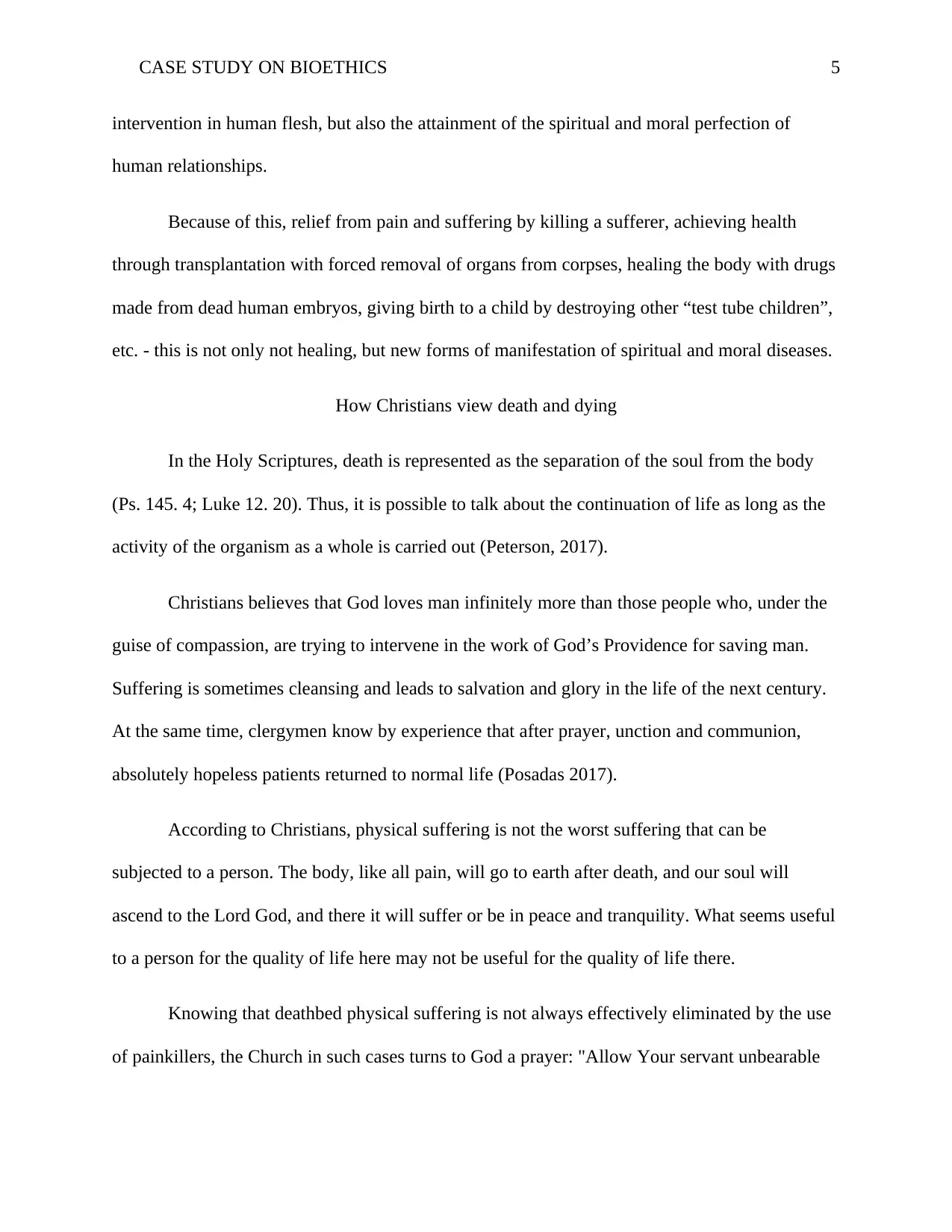
CASE STUDY ON BIOETHICS 5
intervention in human flesh, but also the attainment of the spiritual and moral perfection of
human relationships.
Because of this, relief from pain and suffering by killing a sufferer, achieving health
through transplantation with forced removal of organs from corpses, healing the body with drugs
made from dead human embryos, giving birth to a child by destroying other “test tube children”,
etc. - this is not only not healing, but new forms of manifestation of spiritual and moral diseases.
How Christians view death and dying
In the Holy Scriptures, death is represented as the separation of the soul from the body
(Ps. 145. 4; Luke 12. 20). Thus, it is possible to talk about the continuation of life as long as the
activity of the organism as a whole is carried out (Peterson, 2017).
Christians believes that God loves man infinitely more than those people who, under the
guise of compassion, are trying to intervene in the work of God’s Providence for saving man.
Suffering is sometimes cleansing and leads to salvation and glory in the life of the next century.
At the same time, clergymen know by experience that after prayer, unction and communion,
absolutely hopeless patients returned to normal life (Posadas 2017).
According to Christians, physical suffering is not the worst suffering that can be
subjected to a person. The body, like all pain, will go to earth after death, and our soul will
ascend to the Lord God, and there it will suffer or be in peace and tranquility. What seems useful
to a person for the quality of life here may not be useful for the quality of life there.
Knowing that deathbed physical suffering is not always effectively eliminated by the use
of painkillers, the Church in such cases turns to God a prayer: "Allow Your servant unbearable
intervention in human flesh, but also the attainment of the spiritual and moral perfection of
human relationships.
Because of this, relief from pain and suffering by killing a sufferer, achieving health
through transplantation with forced removal of organs from corpses, healing the body with drugs
made from dead human embryos, giving birth to a child by destroying other “test tube children”,
etc. - this is not only not healing, but new forms of manifestation of spiritual and moral diseases.
How Christians view death and dying
In the Holy Scriptures, death is represented as the separation of the soul from the body
(Ps. 145. 4; Luke 12. 20). Thus, it is possible to talk about the continuation of life as long as the
activity of the organism as a whole is carried out (Peterson, 2017).
Christians believes that God loves man infinitely more than those people who, under the
guise of compassion, are trying to intervene in the work of God’s Providence for saving man.
Suffering is sometimes cleansing and leads to salvation and glory in the life of the next century.
At the same time, clergymen know by experience that after prayer, unction and communion,
absolutely hopeless patients returned to normal life (Posadas 2017).
According to Christians, physical suffering is not the worst suffering that can be
subjected to a person. The body, like all pain, will go to earth after death, and our soul will
ascend to the Lord God, and there it will suffer or be in peace and tranquility. What seems useful
to a person for the quality of life here may not be useful for the quality of life there.
Knowing that deathbed physical suffering is not always effectively eliminated by the use
of painkillers, the Church in such cases turns to God a prayer: "Allow Your servant unbearable
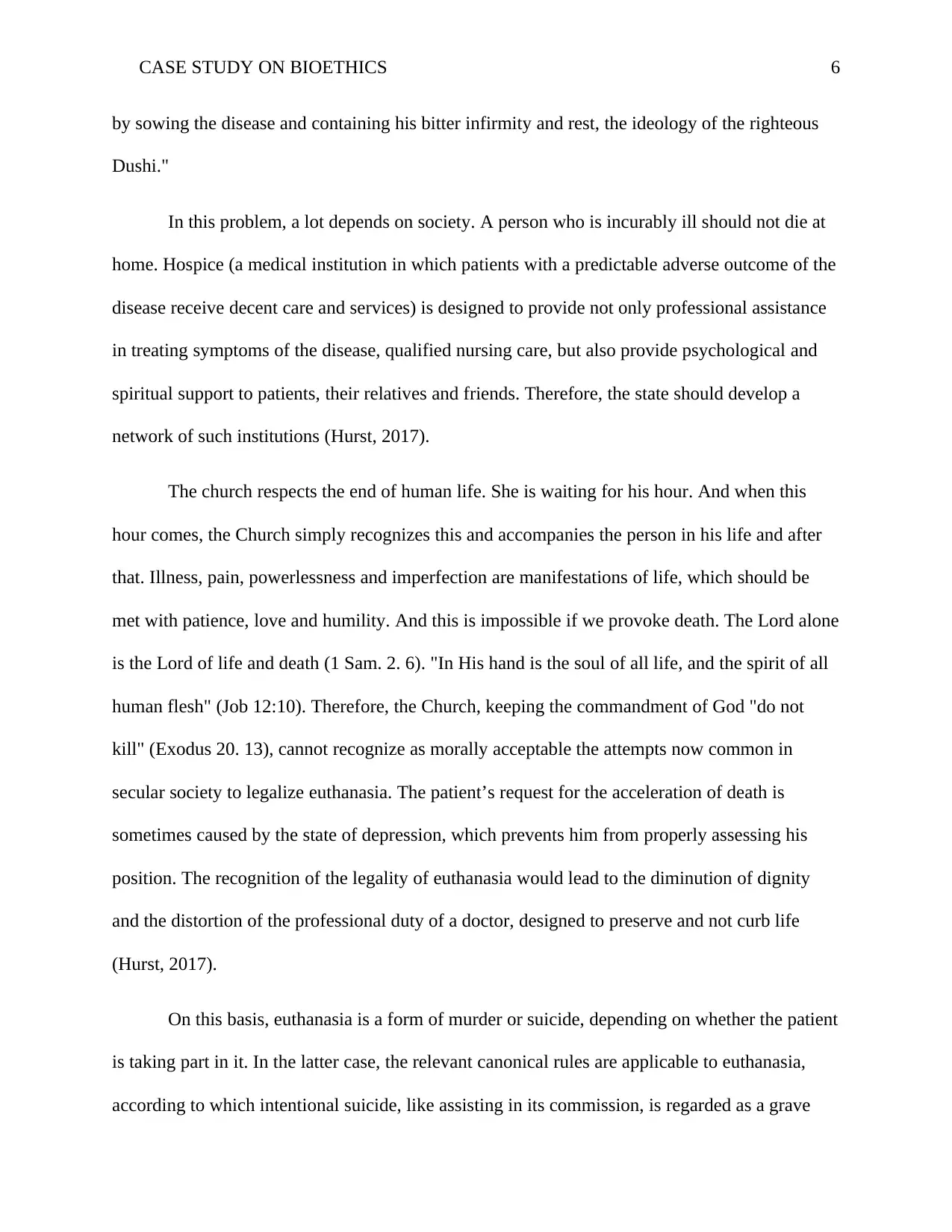
CASE STUDY ON BIOETHICS 6
by sowing the disease and containing his bitter infirmity and rest, the ideology of the righteous
Dushi."
In this problem, a lot depends on society. A person who is incurably ill should not die at
home. Hospice (a medical institution in which patients with a predictable adverse outcome of the
disease receive decent care and services) is designed to provide not only professional assistance
in treating symptoms of the disease, qualified nursing care, but also provide psychological and
spiritual support to patients, their relatives and friends. Therefore, the state should develop a
network of such institutions (Hurst, 2017).
The church respects the end of human life. She is waiting for his hour. And when this
hour comes, the Church simply recognizes this and accompanies the person in his life and after
that. Illness, pain, powerlessness and imperfection are manifestations of life, which should be
met with patience, love and humility. And this is impossible if we provoke death. The Lord alone
is the Lord of life and death (1 Sam. 2. 6). "In His hand is the soul of all life, and the spirit of all
human flesh" (Job 12:10). Therefore, the Church, keeping the commandment of God "do not
kill" (Exodus 20. 13), cannot recognize as morally acceptable the attempts now common in
secular society to legalize euthanasia. The patient’s request for the acceleration of death is
sometimes caused by the state of depression, which prevents him from properly assessing his
position. The recognition of the legality of euthanasia would lead to the diminution of dignity
and the distortion of the professional duty of a doctor, designed to preserve and not curb life
(Hurst, 2017).
On this basis, euthanasia is a form of murder or suicide, depending on whether the patient
is taking part in it. In the latter case, the relevant canonical rules are applicable to euthanasia,
according to which intentional suicide, like assisting in its commission, is regarded as a grave
by sowing the disease and containing his bitter infirmity and rest, the ideology of the righteous
Dushi."
In this problem, a lot depends on society. A person who is incurably ill should not die at
home. Hospice (a medical institution in which patients with a predictable adverse outcome of the
disease receive decent care and services) is designed to provide not only professional assistance
in treating symptoms of the disease, qualified nursing care, but also provide psychological and
spiritual support to patients, their relatives and friends. Therefore, the state should develop a
network of such institutions (Hurst, 2017).
The church respects the end of human life. She is waiting for his hour. And when this
hour comes, the Church simply recognizes this and accompanies the person in his life and after
that. Illness, pain, powerlessness and imperfection are manifestations of life, which should be
met with patience, love and humility. And this is impossible if we provoke death. The Lord alone
is the Lord of life and death (1 Sam. 2. 6). "In His hand is the soul of all life, and the spirit of all
human flesh" (Job 12:10). Therefore, the Church, keeping the commandment of God "do not
kill" (Exodus 20. 13), cannot recognize as morally acceptable the attempts now common in
secular society to legalize euthanasia. The patient’s request for the acceleration of death is
sometimes caused by the state of depression, which prevents him from properly assessing his
position. The recognition of the legality of euthanasia would lead to the diminution of dignity
and the distortion of the professional duty of a doctor, designed to preserve and not curb life
(Hurst, 2017).
On this basis, euthanasia is a form of murder or suicide, depending on whether the patient
is taking part in it. In the latter case, the relevant canonical rules are applicable to euthanasia,
according to which intentional suicide, like assisting in its commission, is regarded as a grave
⊘ This is a preview!⊘
Do you want full access?
Subscribe today to unlock all pages.

Trusted by 1+ million students worldwide
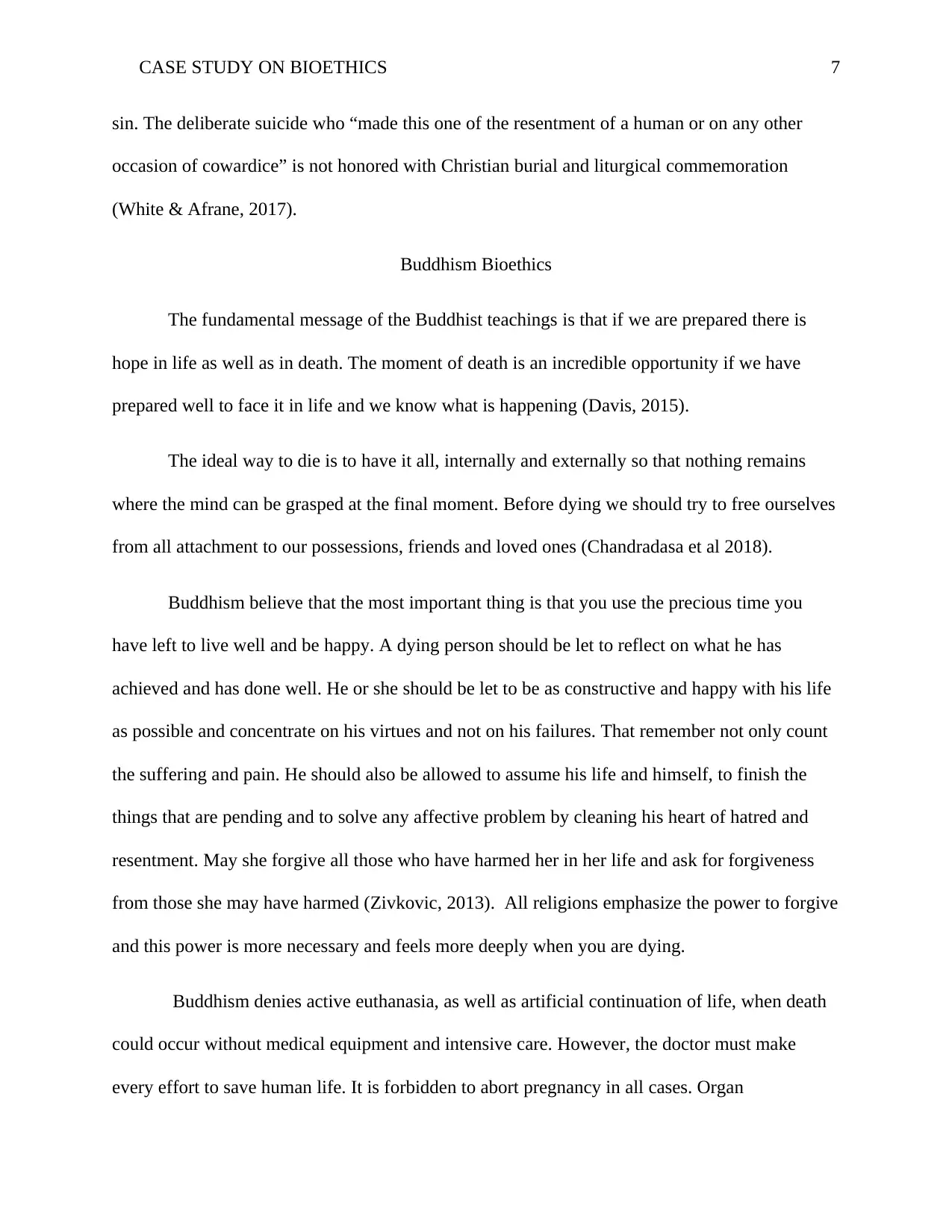
CASE STUDY ON BIOETHICS 7
sin. The deliberate suicide who “made this one of the resentment of a human or on any other
occasion of cowardice” is not honored with Christian burial and liturgical commemoration
(White & Afrane, 2017).
Buddhism Bioethics
The fundamental message of the Buddhist teachings is that if we are prepared there is
hope in life as well as in death. The moment of death is an incredible opportunity if we have
prepared well to face it in life and we know what is happening (Davis, 2015).
The ideal way to die is to have it all, internally and externally so that nothing remains
where the mind can be grasped at the final moment. Before dying we should try to free ourselves
from all attachment to our possessions, friends and loved ones (Chandradasa et al 2018).
Buddhism believe that the most important thing is that you use the precious time you
have left to live well and be happy. A dying person should be let to reflect on what he has
achieved and has done well. He or she should be let to be as constructive and happy with his life
as possible and concentrate on his virtues and not on his failures. That remember not only count
the suffering and pain. He should also be allowed to assume his life and himself, to finish the
things that are pending and to solve any affective problem by cleaning his heart of hatred and
resentment. May she forgive all those who have harmed her in her life and ask for forgiveness
from those she may have harmed (Zivkovic, 2013). All religions emphasize the power to forgive
and this power is more necessary and feels more deeply when you are dying.
Buddhism denies active euthanasia, as well as artificial continuation of life, when death
could occur without medical equipment and intensive care. However, the doctor must make
every effort to save human life. It is forbidden to abort pregnancy in all cases. Organ
sin. The deliberate suicide who “made this one of the resentment of a human or on any other
occasion of cowardice” is not honored with Christian burial and liturgical commemoration
(White & Afrane, 2017).
Buddhism Bioethics
The fundamental message of the Buddhist teachings is that if we are prepared there is
hope in life as well as in death. The moment of death is an incredible opportunity if we have
prepared well to face it in life and we know what is happening (Davis, 2015).
The ideal way to die is to have it all, internally and externally so that nothing remains
where the mind can be grasped at the final moment. Before dying we should try to free ourselves
from all attachment to our possessions, friends and loved ones (Chandradasa et al 2018).
Buddhism believe that the most important thing is that you use the precious time you
have left to live well and be happy. A dying person should be let to reflect on what he has
achieved and has done well. He or she should be let to be as constructive and happy with his life
as possible and concentrate on his virtues and not on his failures. That remember not only count
the suffering and pain. He should also be allowed to assume his life and himself, to finish the
things that are pending and to solve any affective problem by cleaning his heart of hatred and
resentment. May she forgive all those who have harmed her in her life and ask for forgiveness
from those she may have harmed (Zivkovic, 2013). All religions emphasize the power to forgive
and this power is more necessary and feels more deeply when you are dying.
Buddhism denies active euthanasia, as well as artificial continuation of life, when death
could occur without medical equipment and intensive care. However, the doctor must make
every effort to save human life. It is forbidden to abort pregnancy in all cases. Organ
Paraphrase This Document
Need a fresh take? Get an instant paraphrase of this document with our AI Paraphraser
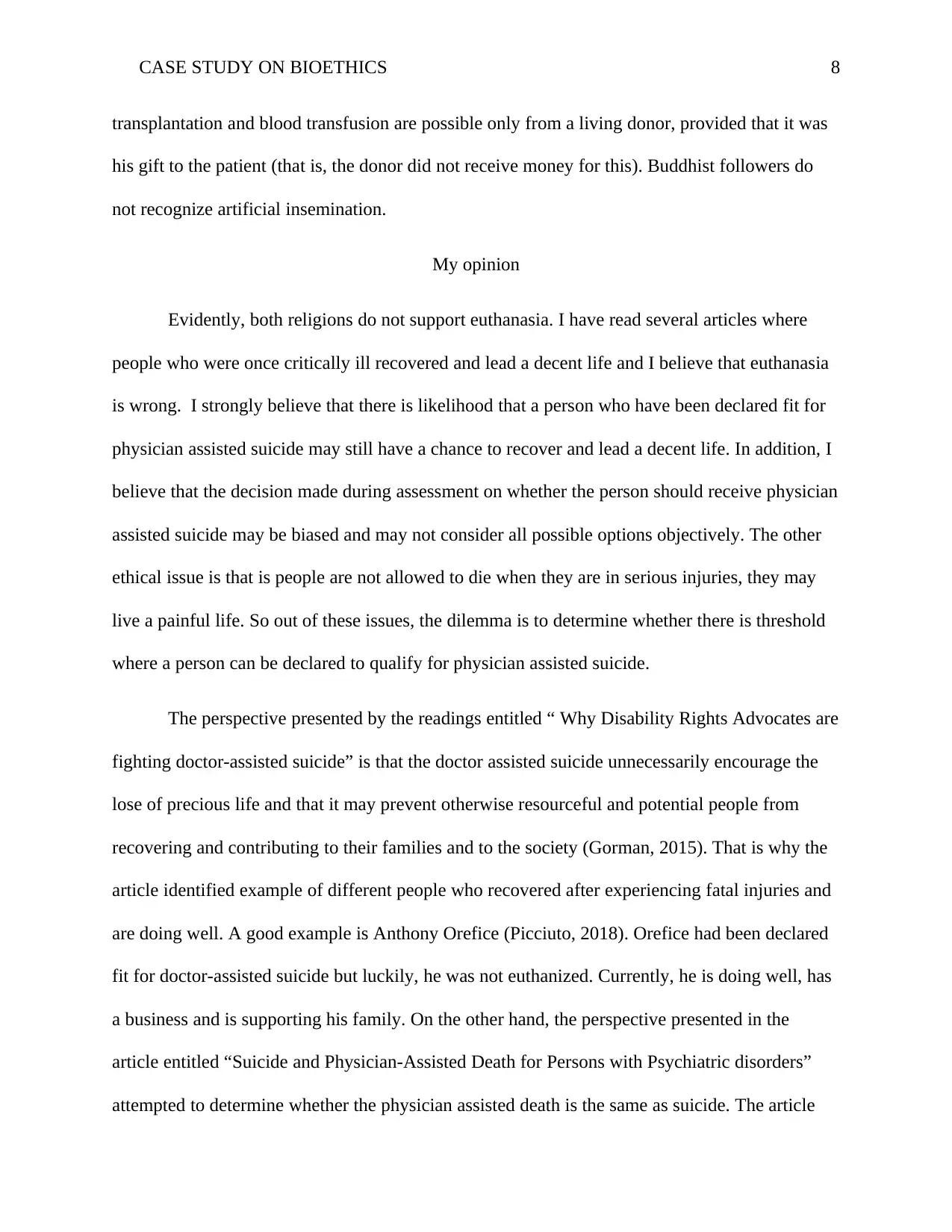
CASE STUDY ON BIOETHICS 8
transplantation and blood transfusion are possible only from a living donor, provided that it was
his gift to the patient (that is, the donor did not receive money for this). Buddhist followers do
not recognize artificial insemination.
My opinion
Evidently, both religions do not support euthanasia. I have read several articles where
people who were once critically ill recovered and lead a decent life and I believe that euthanasia
is wrong. I strongly believe that there is likelihood that a person who have been declared fit for
physician assisted suicide may still have a chance to recover and lead a decent life. In addition, I
believe that the decision made during assessment on whether the person should receive physician
assisted suicide may be biased and may not consider all possible options objectively. The other
ethical issue is that is people are not allowed to die when they are in serious injuries, they may
live a painful life. So out of these issues, the dilemma is to determine whether there is threshold
where a person can be declared to qualify for physician assisted suicide.
The perspective presented by the readings entitled “ Why Disability Rights Advocates are
fighting doctor-assisted suicide” is that the doctor assisted suicide unnecessarily encourage the
lose of precious life and that it may prevent otherwise resourceful and potential people from
recovering and contributing to their families and to the society (Gorman, 2015). That is why the
article identified example of different people who recovered after experiencing fatal injuries and
are doing well. A good example is Anthony Orefice (Picciuto, 2018). Orefice had been declared
fit for doctor-assisted suicide but luckily, he was not euthanized. Currently, he is doing well, has
a business and is supporting his family. On the other hand, the perspective presented in the
article entitled “Suicide and Physician-Assisted Death for Persons with Psychiatric disorders”
attempted to determine whether the physician assisted death is the same as suicide. The article
transplantation and blood transfusion are possible only from a living donor, provided that it was
his gift to the patient (that is, the donor did not receive money for this). Buddhist followers do
not recognize artificial insemination.
My opinion
Evidently, both religions do not support euthanasia. I have read several articles where
people who were once critically ill recovered and lead a decent life and I believe that euthanasia
is wrong. I strongly believe that there is likelihood that a person who have been declared fit for
physician assisted suicide may still have a chance to recover and lead a decent life. In addition, I
believe that the decision made during assessment on whether the person should receive physician
assisted suicide may be biased and may not consider all possible options objectively. The other
ethical issue is that is people are not allowed to die when they are in serious injuries, they may
live a painful life. So out of these issues, the dilemma is to determine whether there is threshold
where a person can be declared to qualify for physician assisted suicide.
The perspective presented by the readings entitled “ Why Disability Rights Advocates are
fighting doctor-assisted suicide” is that the doctor assisted suicide unnecessarily encourage the
lose of precious life and that it may prevent otherwise resourceful and potential people from
recovering and contributing to their families and to the society (Gorman, 2015). That is why the
article identified example of different people who recovered after experiencing fatal injuries and
are doing well. A good example is Anthony Orefice (Picciuto, 2018). Orefice had been declared
fit for doctor-assisted suicide but luckily, he was not euthanized. Currently, he is doing well, has
a business and is supporting his family. On the other hand, the perspective presented in the
article entitled “Suicide and Physician-Assisted Death for Persons with Psychiatric disorders”
attempted to determine whether the physician assisted death is the same as suicide. The article
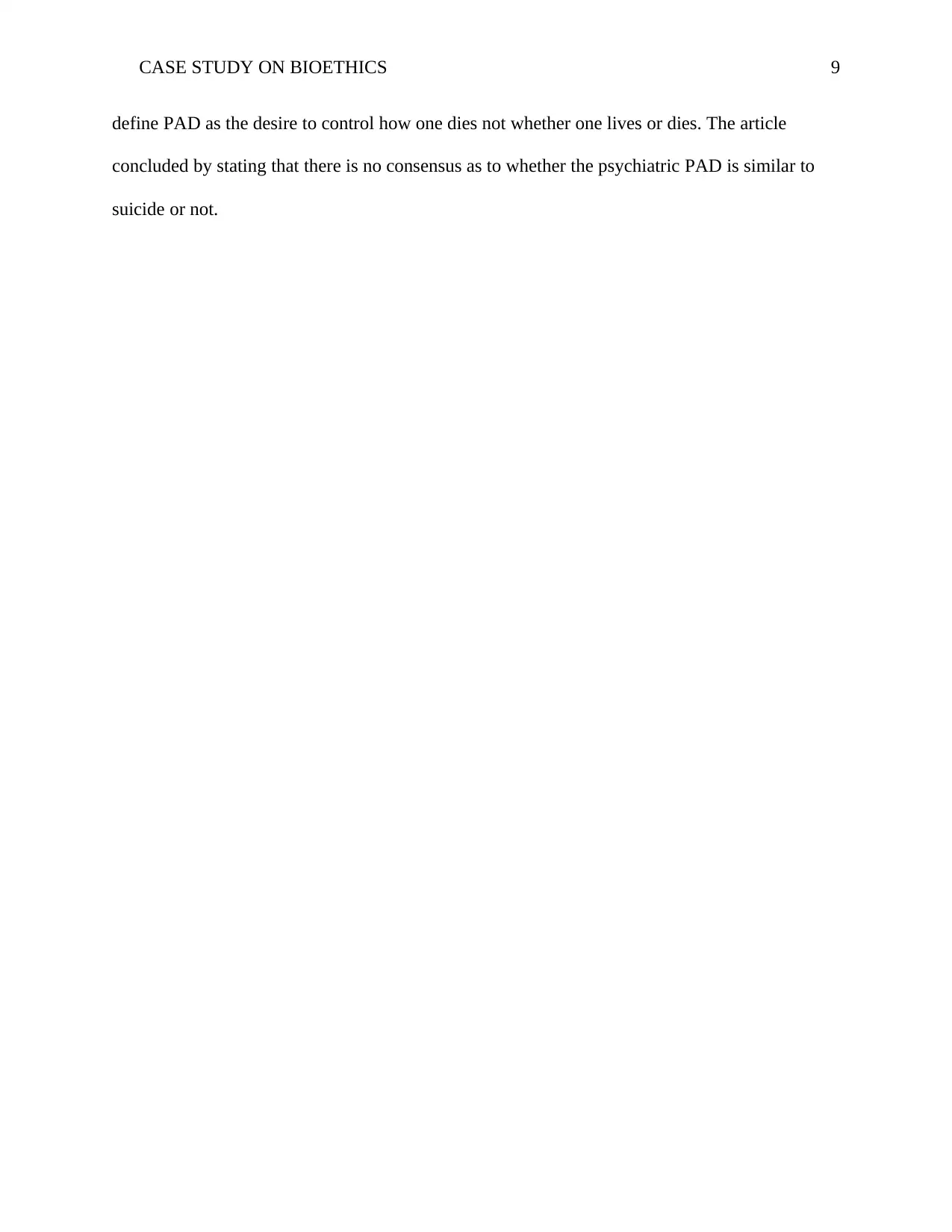
CASE STUDY ON BIOETHICS 9
define PAD as the desire to control how one dies not whether one lives or dies. The article
concluded by stating that there is no consensus as to whether the psychiatric PAD is similar to
suicide or not.
define PAD as the desire to control how one dies not whether one lives or dies. The article
concluded by stating that there is no consensus as to whether the psychiatric PAD is similar to
suicide or not.
⊘ This is a preview!⊘
Do you want full access?
Subscribe today to unlock all pages.

Trusted by 1+ million students worldwide
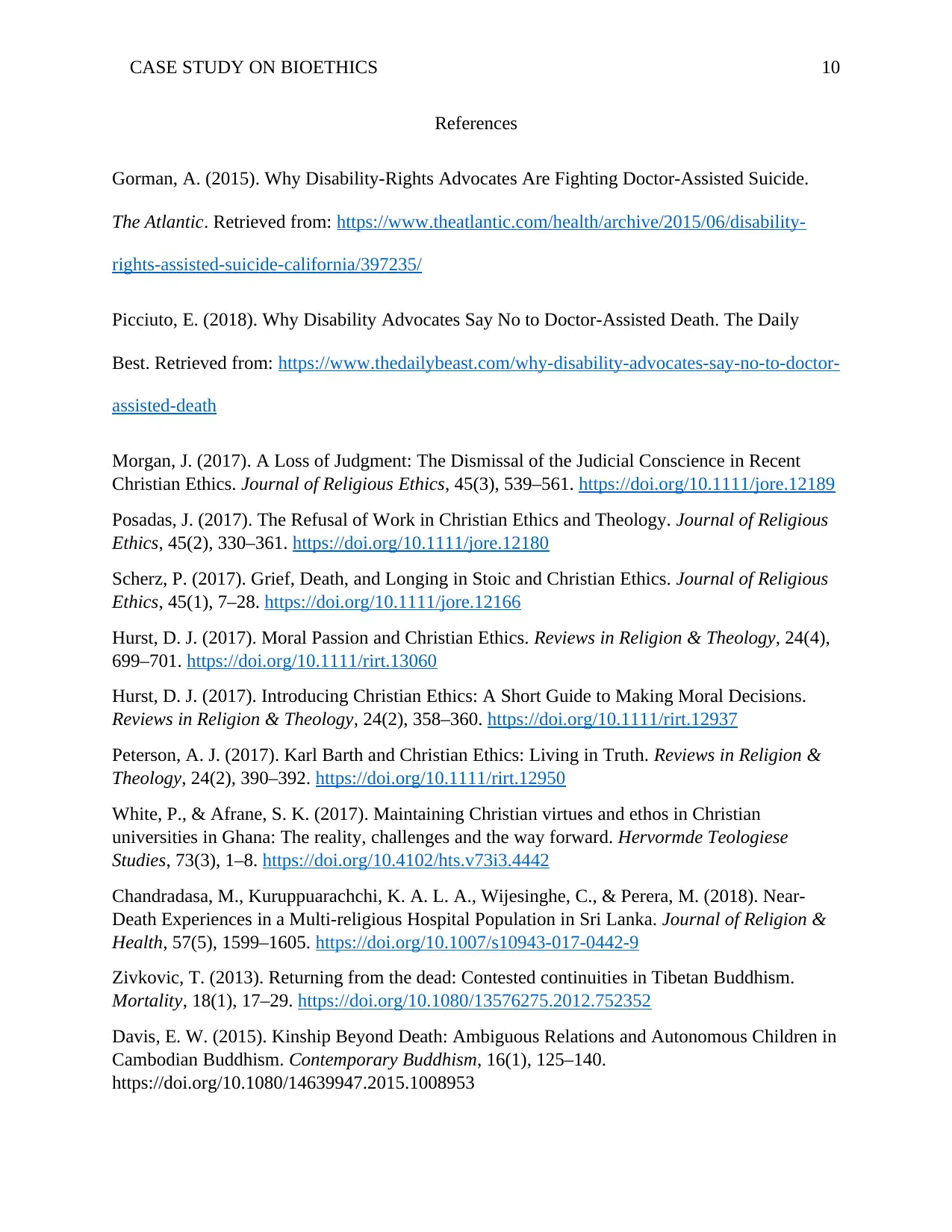
CASE STUDY ON BIOETHICS 10
References
Gorman, A. (2015). Why Disability-Rights Advocates Are Fighting Doctor-Assisted Suicide.
The Atlantic. Retrieved from: https://www.theatlantic.com/health/archive/2015/06/disability-
rights-assisted-suicide-california/397235/
Picciuto, E. (2018). Why Disability Advocates Say No to Doctor-Assisted Death. The Daily
Best. Retrieved from: https://www.thedailybeast.com/why-disability-advocates-say-no-to-doctor-
assisted-death
Morgan, J. (2017). A Loss of Judgment: The Dismissal of the Judicial Conscience in Recent
Christian Ethics. Journal of Religious Ethics, 45(3), 539–561. https://doi.org/10.1111/jore.12189
Posadas, J. (2017). The Refusal of Work in Christian Ethics and Theology. Journal of Religious
Ethics, 45(2), 330–361. https://doi.org/10.1111/jore.12180
Scherz, P. (2017). Grief, Death, and Longing in Stoic and Christian Ethics. Journal of Religious
Ethics, 45(1), 7–28. https://doi.org/10.1111/jore.12166
Hurst, D. J. (2017). Moral Passion and Christian Ethics. Reviews in Religion & Theology, 24(4),
699–701. https://doi.org/10.1111/rirt.13060
Hurst, D. J. (2017). Introducing Christian Ethics: A Short Guide to Making Moral Decisions.
Reviews in Religion & Theology, 24(2), 358–360. https://doi.org/10.1111/rirt.12937
Peterson, A. J. (2017). Karl Barth and Christian Ethics: Living in Truth. Reviews in Religion &
Theology, 24(2), 390–392. https://doi.org/10.1111/rirt.12950
White, P., & Afrane, S. K. (2017). Maintaining Christian virtues and ethos in Christian
universities in Ghana: The reality, challenges and the way forward. Hervormde Teologiese
Studies, 73(3), 1–8. https://doi.org/10.4102/hts.v73i3.4442
Chandradasa, M., Kuruppuarachchi, K. A. L. A., Wijesinghe, C., & Perera, M. (2018). Near-
Death Experiences in a Multi-religious Hospital Population in Sri Lanka. Journal of Religion &
Health, 57(5), 1599–1605. https://doi.org/10.1007/s10943-017-0442-9
Zivkovic, T. (2013). Returning from the dead: Contested continuities in Tibetan Buddhism.
Mortality, 18(1), 17–29. https://doi.org/10.1080/13576275.2012.752352
Davis, E. W. (2015). Kinship Beyond Death: Ambiguous Relations and Autonomous Children in
Cambodian Buddhism. Contemporary Buddhism, 16(1), 125–140.
https://doi.org/10.1080/14639947.2015.1008953
References
Gorman, A. (2015). Why Disability-Rights Advocates Are Fighting Doctor-Assisted Suicide.
The Atlantic. Retrieved from: https://www.theatlantic.com/health/archive/2015/06/disability-
rights-assisted-suicide-california/397235/
Picciuto, E. (2018). Why Disability Advocates Say No to Doctor-Assisted Death. The Daily
Best. Retrieved from: https://www.thedailybeast.com/why-disability-advocates-say-no-to-doctor-
assisted-death
Morgan, J. (2017). A Loss of Judgment: The Dismissal of the Judicial Conscience in Recent
Christian Ethics. Journal of Religious Ethics, 45(3), 539–561. https://doi.org/10.1111/jore.12189
Posadas, J. (2017). The Refusal of Work in Christian Ethics and Theology. Journal of Religious
Ethics, 45(2), 330–361. https://doi.org/10.1111/jore.12180
Scherz, P. (2017). Grief, Death, and Longing in Stoic and Christian Ethics. Journal of Religious
Ethics, 45(1), 7–28. https://doi.org/10.1111/jore.12166
Hurst, D. J. (2017). Moral Passion and Christian Ethics. Reviews in Religion & Theology, 24(4),
699–701. https://doi.org/10.1111/rirt.13060
Hurst, D. J. (2017). Introducing Christian Ethics: A Short Guide to Making Moral Decisions.
Reviews in Religion & Theology, 24(2), 358–360. https://doi.org/10.1111/rirt.12937
Peterson, A. J. (2017). Karl Barth and Christian Ethics: Living in Truth. Reviews in Religion &
Theology, 24(2), 390–392. https://doi.org/10.1111/rirt.12950
White, P., & Afrane, S. K. (2017). Maintaining Christian virtues and ethos in Christian
universities in Ghana: The reality, challenges and the way forward. Hervormde Teologiese
Studies, 73(3), 1–8. https://doi.org/10.4102/hts.v73i3.4442
Chandradasa, M., Kuruppuarachchi, K. A. L. A., Wijesinghe, C., & Perera, M. (2018). Near-
Death Experiences in a Multi-religious Hospital Population in Sri Lanka. Journal of Religion &
Health, 57(5), 1599–1605. https://doi.org/10.1007/s10943-017-0442-9
Zivkovic, T. (2013). Returning from the dead: Contested continuities in Tibetan Buddhism.
Mortality, 18(1), 17–29. https://doi.org/10.1080/13576275.2012.752352
Davis, E. W. (2015). Kinship Beyond Death: Ambiguous Relations and Autonomous Children in
Cambodian Buddhism. Contemporary Buddhism, 16(1), 125–140.
https://doi.org/10.1080/14639947.2015.1008953
Paraphrase This Document
Need a fresh take? Get an instant paraphrase of this document with our AI Paraphraser
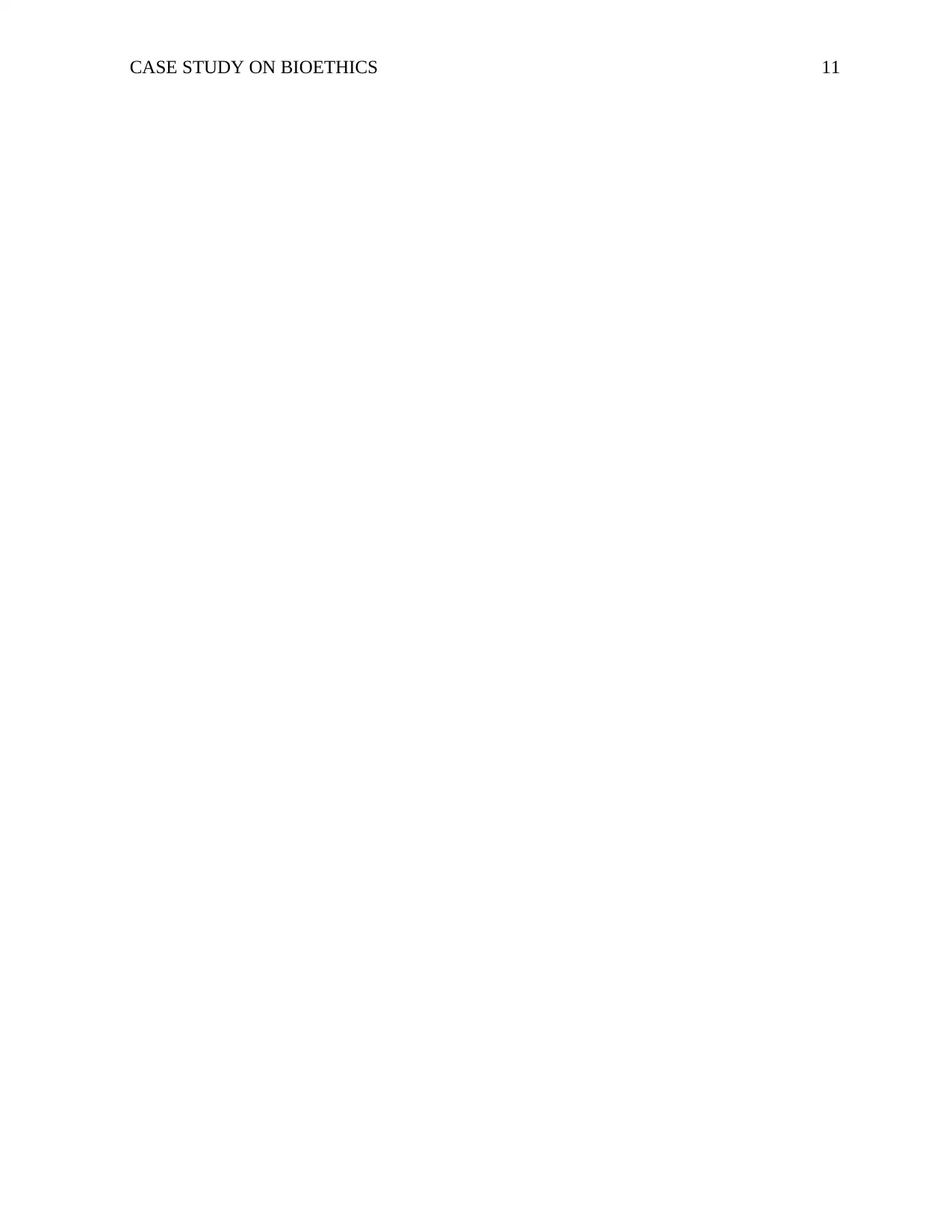
CASE STUDY ON BIOETHICS 11
1 out of 11
Related Documents
Your All-in-One AI-Powered Toolkit for Academic Success.
+13062052269
info@desklib.com
Available 24*7 on WhatsApp / Email
![[object Object]](/_next/static/media/star-bottom.7253800d.svg)
Unlock your academic potential
Copyright © 2020–2025 A2Z Services. All Rights Reserved. Developed and managed by ZUCOL.





